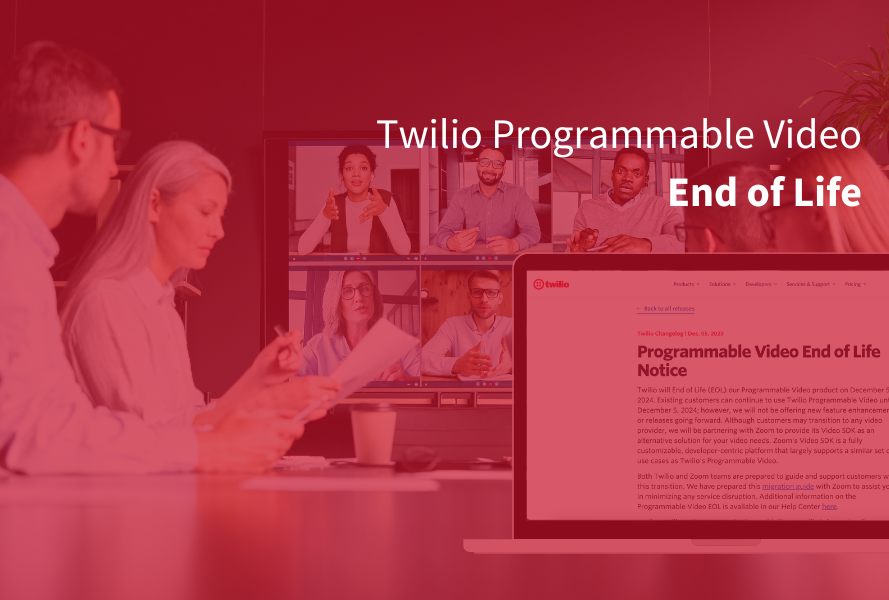Twilio Programmable Video Ending: What now for Customers?
Twilio Programmable Video is ending. Why Yameo is ideally suited to help ensure continuity of service and optimize communication solutions for Customers.
On December 5th, 2023, Twilio announced they would be ending their Programmable Video service in 12 months’ time. No new feature enhancements or releases will be performed. For Twilio customers relying on programmable video, this has created uncertainty around their video-supported services heading into 2024. In a landscape where good customer experience is vital to stay competitive, this announcement puts a huge strain on companies to act quickly and effectively. So, what can Twilio customers do?
In Twilio’s End-of-Life announcement they recommend Zoom SDK as a replacement option. However, this drastically means a downgrade in performance, approach to innovation and unfortunately the customer now has two vendors to support their solution, when previously they had just one. I am here to show you why Yameo, technological partner of Vonage, can be the ideal fit for Twilio programmable video customers. Transition can be challenging, but in this situation, it is a necessity.

Yameo and Vonage
A quick intro about Yameo and Vonage, and how we work together. Yameo has been a custom software house providing both back- & front-end solutions for companies in various industries since 2006. One of our core areas of expertise is customer-facing solutions where we utilize Video, SMS, Chat, WhatsApp, Voice, and Email to enhance customer experiences. Vonage, as the global leader in Communications APIs is our trusted partner, we work with to deliver full-scope projects to companies to satisfy 100% of their requirements. Together with Vonage Communication APIs we have developed and delivered custom solutions for banks, insurance companies and retailers across Europe since 2019.
Why Zoom is not an ideal replacement solution for Twilio Programmable Video
According to Zoom’s dedicated Twilio page it is 1:1 replacement with more options compared to Twilio. They offer a custom video experience based on Zoom’s core technology where you can select from features to build your solution. However, there are several issues I see with this:
- Their web experience is not on par with other solutions like Vonage, and even Twilio. Since they rely on WebTransport+WebCodecs+WebAssembly this means a less stable experience compared to WebRTC. Add to that this would not only be a tech shift for Twilio customers, but it would also require relearning and training in terms of and reliance on this new technology. All considered it is a risky decision for Twilio customers to make.
-
- A sub-point worth mentioning is that Zoom’s approach means it is effectively ‘locked out’ of the ecosystem benefit that comes from using a standard like WebRTC. These open standards perform far better than proprietary stacks like Zoom’s H.264 video codec in features, flexibility, and security in the long-term.
-
- End-to-end encryption is not supported in the Zoom Video SDKs for developers. In their Twilio transition guide it states, “Zoom Video SDK is encrypted in transit….” From a business perspective, this means switching from Twilio’s end-to-end encryption to Zoom’s encrypted in transit can pose legal, compliancy and customer trust issues.
-
- Industry standards worldwide differ, but if we look at US-based telehealth solutions who require HIPAA certification, e2ee is a recommended requirement.
- Whilst in Europe GDPR compliancy does not mandate e2ee, Article 34.3 requires the controller to communicate any and all personal data breaches to the data subject when it affects individual personal data. End-to-end encryption eliminates the need to notify impacted data subjects because there is no impact on their rights when encrypted data is involved. Important here is to ensure encryption keys stay secure.
- Zoom’s Web Video SDK is not as extensive as other providers. Developers transitioning from WebRTC platforms will find many ‘standard features’ missing. Below is a key overview of feature gaps.
-
- Standard HTML video & audio elements not supported: Video rendering is only supported via single canvas elements. This creates performance issues for web-apps and limits aspects like styling via CSS.
- Styling and Positioning requires a lot of code: Because all inbound video streams must be drawn on a single canvas and can only be drawn as 16:9 rectangles, creating anything other than a quite simple UX requires a lot of code.
- Max. Video resolution of 720p: Zoom sets hard limits at 720p, meaning use cases requiring higher resolutions are not possible.
- No low-level video simulcast control: Zoom provides default send- and receive-side bandwidth and video quality management. These do not work well in the Zoom Web SDK and are not flexible enough to deliver the best possible user experience across the full range of real-world use cases.
- Limited Debugging Information: WebRTC developers rely on a combination of: standards-based debugging and testing tools like Chrome’s webrtc-internals interface and testRTC, and platform-specific metrics and logs. Zoom’s proprietary approach means that standard video debugging and performance optimization tools mostly are not useful. And the Zoom platform does not offer any detailed post-session logs or metrics data.
- No access to raw media tracks: The Zoom Web SDK does not give access to raw audio or video data. This makes it impossible to build applications that do any processing of inbound audio or video. For example, you cannot do any filtering or analysis of audio, cannot implement client-side transcription, and cannot build AI-powered video features like face filters.
- No React helper libraries: The React front-end framework is widely used for dynamic, single-page web apps. React offers sophisticated state management features and a powerful virtual DOM abstraction. Some of React’s abstractions are tricky to use efficiently and safely in combination with real-time video and audio elements. For this reason, many WebRTC platforms offer React-specific helper libraries. For example: Vonage’s opentok-react.
- Zoom Web SDK performance issues: The Zoom Web SDK uses some components of Zoom’s proprietary video stack, combined with some parts of the web browser’s native WebRTC support. This is a creative approach, but it results in high CPU usage, video quality problems, and call scaling issues.
- Video Quality: Zoom encodes and decodes video and audio using custom WebAssembly modules rather than the web’s standard codecs. This means that the solution uses more CPU than the native browser WebRTC stack does. Zoom’s web video resolution is limited to 720p and is often lower in real-world situations, especially on older devices and most mobile phones (even current-generation iPhones).
- Higher CPU Usage: Efficient CPU usage is critical for video applications. The Zoom Web SDK cannot make use of the highly optimized H.264 and VP8 codecs that are built into today’s web browsers.
- Region Locking is an expensive option with Zoom SDK since you need a minimum Pro Account. This feature enables customers to ‘lock’ their digital rights management to data centers in certain regions. A key feature for customers in regions which require this, such as in the European Union.
- Innovation of the platform is a key aspect for customers. Whereas Twilio will not do any new releases it is vital for customers to transition to a platform that does. Zoom Video SDK compared to their native Zoom application is lagging. Feature-wise, performance-wise, and usage-based their native applications for iOS and Android outpace their Zoom SDK. You can ask yourself if the Zoom SDK is their priority to invest in future features and updates.
- Recording Flexibility is limited to full recording of the video from all sides, whilst other solutions provide the option to record which side of the video connection is recorded.

The Business Benefit of Yameo and Vonage for Twilio Programmable Video Customers
Whilst the Zoom SDK is by far not the ideal fit for web-based video solutions running on Twilio Programmable Video, it also means a split in vendors to support one solution. A quick scan of the Twilio customer base shows that solutions often include video + SMS/Email/WhatsApp. A transition to Zoom may take care of your video needs, however it splits support of a solution from one vendor to two.
1:1 Match with Twilio + Voice, SMS, WhatsApp, Email
Here is the benefit of using Yameo and Vonage together, since Vonage as a global leader in Communication APIs can also provide those services such as Voice, SMS, Email or WhatsApp. Yameo as tech partner has expertise in implementing those services in a video-based solution. This mitigates the risk for Twilio customers that must transition and continues to offer them the benefit of one vendor for their solution.
Priority platform that innovates
Vonage’s Video Communications API platform is a key part of their value proposition. Regular innovations and new releases are common for web-based video users. Ericsson, which recently purchased Vonage has ensured a continued investment and strategic importance of the video communication APIs. Moreover, Yameo as tech partner has the expertise to develop additional custom features based on each customer’s particular use cases. This has been our approach since 2019.
Better Video performance, better security, and more features
Especially for web-based video solutions, Vonage and Yameo provide a far superior experience compared to the Zoom SDK. Technical stability ensures a better performance of video solutions and hence better customer experiences. End-to-end encryption enables a more secure experience and lowers your risk as a provider of that solution. Compared to Zoom SDK, Vonage and Yameo together boast more than 50 features currently not available on the Zoom platform. These include features such as geo-localization, annotations on screen, e-signature, video-identification and more.
Lowered Risks for Twilio Programmable Video Customers
This transition has been forced onto Twilio customers and therefore there is a risk they choose a solution which does not meet their expectations. From a web-based video perspective, the technology used by Zoom means lower quality and performance. Vonage as leader in WebRTC-enabled video communications lowers such risks with its proven technological setup. Yameo as an experienced tech partner has helped various companies transition to new video-supported solutions on the Vonage platform.
We have helped dozens of companies transition their video and communications based solutions to a more successful experience.
“We had previously gone with another company to do remote video inspections and claims handling; however, they did not meet the expected results especially when it comes to web-based solution. We were introduced to Yameo as they had a video solution for claims and remote inspections and did a testing period. After this period, we decided to go with their solution and do some customization to maximize our use cases.”
– Software Development Director at Ergo Hestia, Oskar Jedynasty.
Let Us Sum It Up
Twilio’s announcement has put several companies in a difficult position, and which require tough decisions. Their recommendation is Zoom SDK, a provider of only video-enabled communications. This approach would split projects with other communication channels between two companies. A result that means increased risk for the customer, and from a practical side two partners instead of one.
The Zoom SDK platform, as we have seen, is not ideal in any sense for the web based Twilio customers. The web performance of their video is not on par with Twilio, and other solutions available. Customer experiences will be impacted and limited due to the technical setup. Requirements such as e2ee are not supported, nor are other ‘standard’ features available on other solutions.
Together Yameo and Vonage propose a setup advantageous for Twilio customers that require stable and scalable web-based video communications, and more such as SMS, WhatsApp, Voice, and Email. This approach minimizes the risks for Twilio customers and ensures access to more features than they previously have experienced. And this on a platform that is key part of the business model at Vonage – ensuring continued investment in features, releases, and security.
So where to start for Twilio customers?
A good first step is to get in touch with one of our experts to discuss your concerns regarding this transition away from Twilio’s Programmable Video. Or review our dedicated page answering some of your most important questions. Either way, we believe Yameo and Vonage together can seamlessly help your transition of video and communication APIs to ensure continuity of service.

